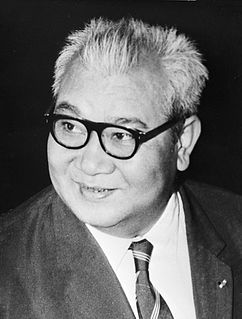
The politics of the Lao People's Democratic Republic takes place in the framework of a one-party socialist republic. The only legal political party is the Lao People's Revolutionary Party (LPRP). The de jure head of state is President Bounnhang Vorachith, who also is LPRP general secretary making him the de facto leader of Laos.
The Lao people or Laotians are a Tai ethnic group native to Southeast Asia, who speak the eponymous language of the Tai–Kadai group, originating from present-day southern China. They are the majority ethnic group of Laos, making up 53.2% of the total population. The majority of Lao people adhere to Theravada Buddhism. They are closely related to other Tai peoples, especially with the Isan people, who are also speakers of Lao language, but native to neighboring Thailand.

The Pathet Lao was a communist political movement and organization in Laos, formed in the mid-20th century. The group was ultimately successful in assuming political power in 1975, after the Laotian Civil War. The Pathet Lao were always closely associated with Vietnamese communists. During the civil war, it was effectively organized, equipped and even led by the People's Army of Vietnam. They fought against the anti-communist forces in the Vietnam War. Eventually, the term became the generic name for Laotian communists.

General Khamtai Siphandone is a Laotian politician who was President of Laos from 24 February 1998, until 8 June 2006, when he was replaced by Choummaly Sayasone. He was a member of the Communist Party of Indochina in 1954 and a member of the Central Committee of the Lao People's Revolutionary Party in 1956.

Laos elects a legislature nationally and the public also participates in the election of village heads. The National Assembly has 149 members, elected for five year terms.
Buddhism is the primary religion of Laos. The Buddhism practiced in Laos is of the Theravada tradition. Lao Buddhism is a unique version of Theravada Buddhism and is at the basis of ethnic Lao culture. Buddhism in Laos is often closely tied to animist beliefs and belief in ancestral spirits, particularly in rural areas.

The National Assembly is the unicameral parliament of Laos. The National Assembly meets in Vientiane.

The Personalist Labor Revolutionary Party, often simply called the Can Lao Party, was a Vietnamese political party, formed in early 1950s by the president of Republic of Vietnam Ngô Đình Diệm and his brother as well as the adviser of the regime, Ngô Đình Nhu.

Parliamentary elections were held in Laos on 4 May 1958, in order to elect an additional 21 seats to the enlarged National Assembly. The Lao Patriotic Front won the most seats, although the ruling National Progressive Party remained the largest party in the Assembly, holding 26 of the 60 seats. Voter turnout was 82.1%.

Dobama Asiayone, commonly known as the Thakhins, was a Burmese nationalist group formed around the 1930s and composed of young, disgruntled intellectuals. Drawing their name from the way in which the British were addressed during colonial times, the party was established by Ba Thaung in May 1930, bringing together traditionalist Buddhist nationalist elements and fresh political ideals. It was significant in stirring up political consciousness in Burma, and drew most of its support base from students.
The Committee for the Defence of National Interests was an anti-communist right-wing political party founded in the Kingdom of Laos on 17 June 1958. Dismayed by the election of Lao communists to the National Assembly in the May 1958 elections, younger politicians and military officers founded CDNI as an alternative to older Lao politicians and senior officers then in power. The CDNI pronounced itself as a force for anti-corruption efforts in the Royal Lao Government. It was backed by the United States embassy; American support was manifested in political advice and civic actions such as Operation Booster Shot. In the 24 April 1960 elections, which were obviously rigged, the CDNI won 32 of 59 seats. The Pathet Lao leadership had been detained during the election; on 23 May 1960, they escaped to join their insurrection in the mountains. This ended the governing coalition, and fighting began in the Laotian Civil War.

Laotian women have long been active participants in their nation's society, involved in politics, driving social transformation and development, becoming active in the world of business and serving as nurses and food producers for the military. Due to modernization and rural uprooting, Lao women have begun to embrace lifestyles that are foreign to traditional Laotian ideals.

The Independent Party was a political party in Laos.

The Democratic Party was a political party in Laos.

The Lao National Union Party was a Buddhist Socialist political party in Laos.

The Lao People's Rally was a political party in Laos.

The Association of Northern Deputies was a political party in Laos.

The Congress of the Lao People's Revolutionary Party (LPRP) is the party's highest decision-making body. The LPRP has convened 10 congresses since its foundation in 1955, and eight since taking power in 1975. According to the party rules, the party congress is to be convened by the LPRP Central Committee (CC) every fifth year. It functions as a forum that approves party policy, is empowered to amend the party's charter and program, and elects the Central Committee. The party leadership, through the Political Report of the Central Committee, briefs the party on its work in the period since its last congress, and sets out future goals for the period in between the next congress.








